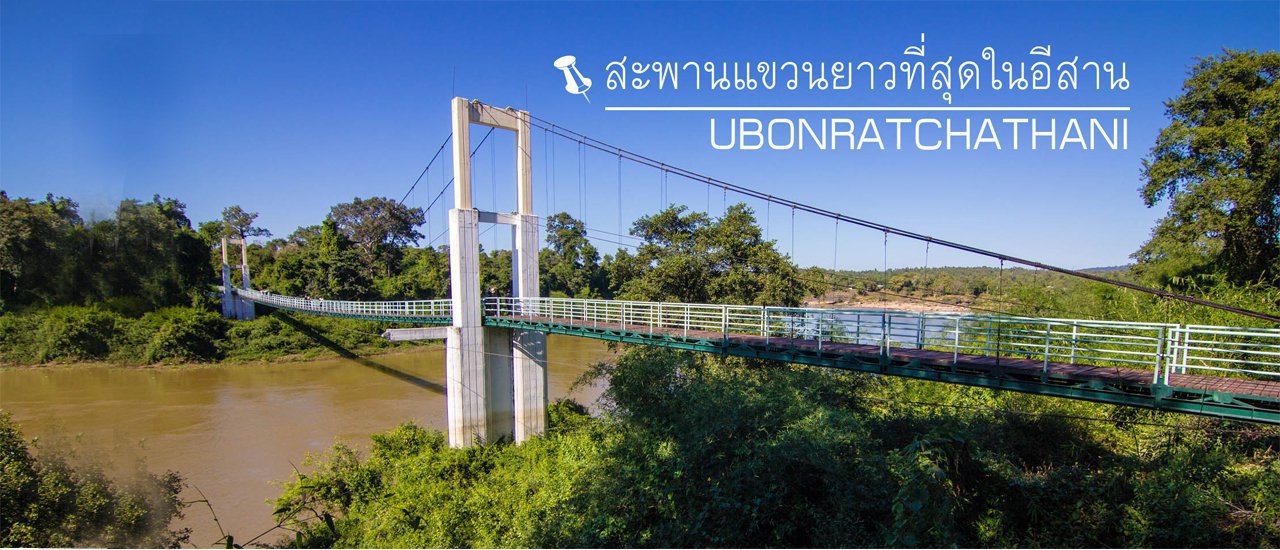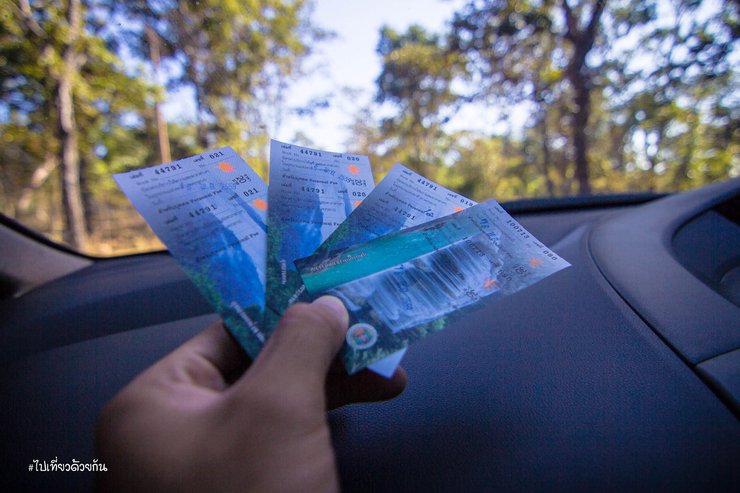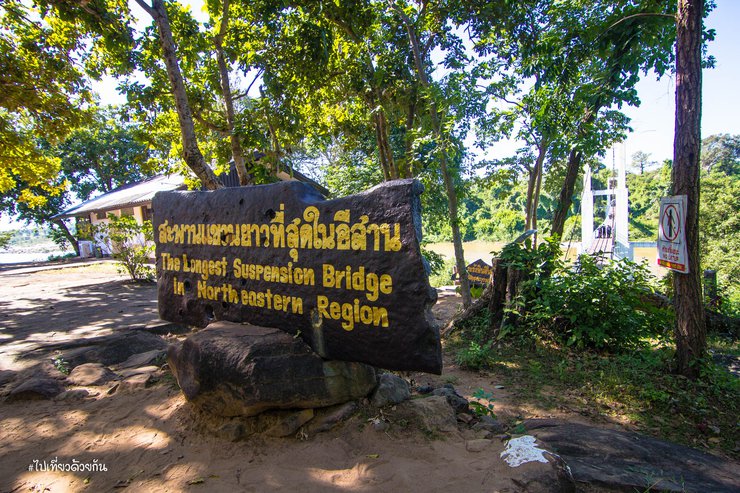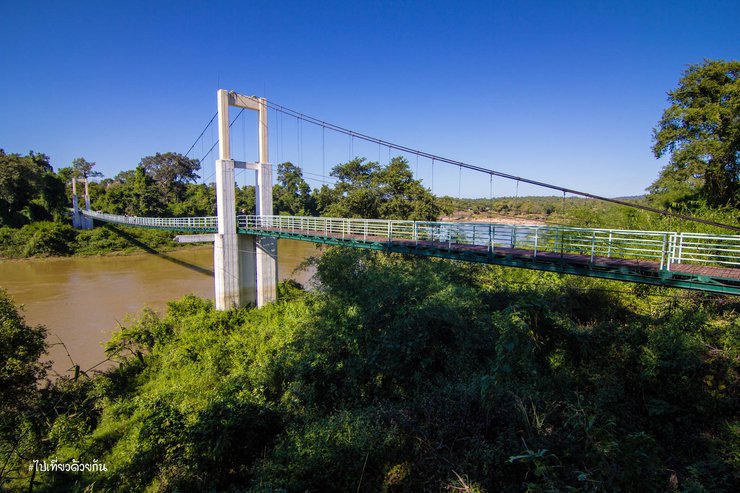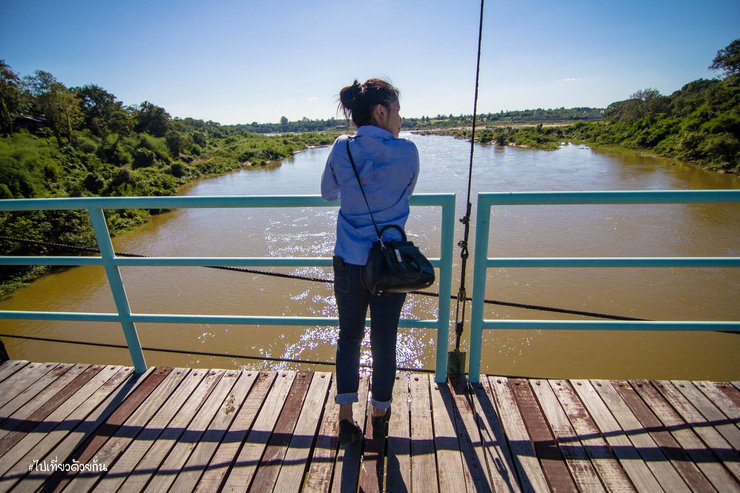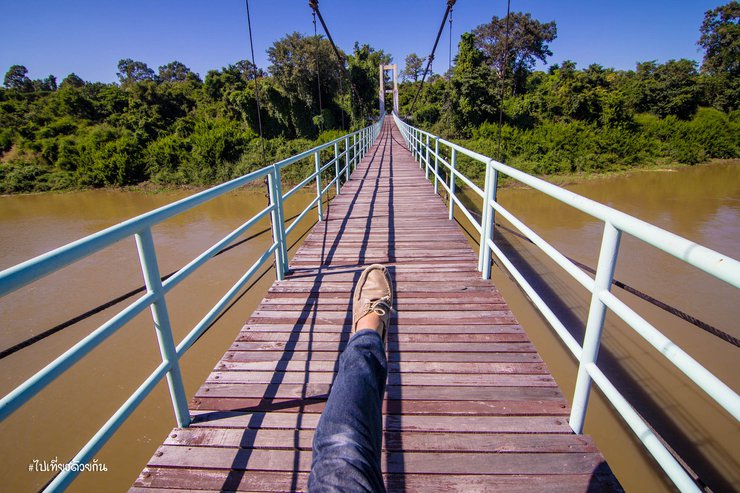On a free day, I visited the longest suspension bridge in the Northeast. It was even more beautiful than my previous visit, as the trees were lush and green. The weather was a bit hot, as I went in the afternoon. This time, I had the opportunity to walk through the forest and emerge at another bridge. There was an identical bridge on the other side of the forest. If you have free time, you should definitely visit. Ubon Ratchathani has many places to explore. This weekend, let's go! The scenery is beautiful, and the Mun River is a muddy brown, like Ovaltine. I forgot to mention that it's in the Pha Taem National Park. The entrance fee is 20 baht per person, and the vehicle fee is 30 baht per vehicle. It's not too far, so let's go!

Admission to the park requires a 20 baht entrance fee per person and a 30 baht vehicle fee.

The provided text is empty. Please provide the text you want me to translate.
The longest suspension bridge in the Northeast.

This is a wide view of the place...

"Before we walk, let's take a picture first… This is the Mun River… The color is a bit cloudy… It looks delicious…"

I was about to walk, but I felt a little scared. It was too high.

The murky brown color of the Mun River

We have reached the middle of the bridge. It's scary...

We have arrived at the other side... It's very green here lately...


If we enter the forest, there will be another bridge on the other side. It's not far to walk.


Let's walk back together. Come visit us… I guarantee you won't be disappointed.
Two Routes to the Destination
There are two routes to reach the destination:
- Route 1: Take Highway 217 (Ubon Ratchathani-Phibun Mangsahan-Chong Mek, approximately 75 kilometers) and then turn left onto Route 2173 for another 13 kilometers.
- Route 2: Take Highway 2222 through Khong Chiam District for approximately 4 kilometers, then cross the Mun River for another 12 kilometers.
Alternatively, you can take the route that crosses the Pak Mun Dam (if the dam is open).
**Don Tanao** is an island in the Mun River, approximately 450 meters wide and 700 meters long. A suspension bridge connects both sides of the island. The northern part of Don Tanao has a sandy beach suitable for relaxation. The island is covered in a dry evergreen forest, providing shade from the large trees. In the mornings and evenings, local residents fish around the island.
Ta Na National Park: A Natural Paradise in Thailand
Ta Na National Park is a haven for nature lovers, boasting stunning landscapes, diverse wildlife, and historical significance. Located in the Ubon Ratchathani province of Thailand, the park encompasses a vast area of lush forests, cascading waterfalls, and towering cliffs.
The Mighty Ta Na Rapids:
The park's centerpiece is the Ta Na Rapids, a series of impressive rapids formed by the Mun River. These rapids are not only a sight to behold but also a testament to the river's power. In the center of the rapids lies a massive rock formation, a natural island created by the relentless force of the water. During the French colonial era, a rectangular structure was built on this island to guide boats navigating the treacherous rapids.
A Haven for Aquatic Life:
The Ta Na Rapids are also home to numerous underwater caves, providing a sanctuary for a variety of fish species. This abundance of aquatic life makes the rapids a popular spot for fishing enthusiasts. The best time to visit the rapids is between January and May, when the water levels are at their lowest.
Suspension Bridge and Breathtaking Views:
A suspension bridge spans the Mun River, connecting the two banks and offering breathtaking views of the surrounding landscape. From the bridge, visitors can marvel at the rapids below and the lush greenery that lines the riverbanks. The bridge also serves as a gateway to the Don Ta Na, a natural area perfect for leisurely walks and nature exploration.
Historical and Cultural Significance:
Ta Na National Park holds historical and cultural significance. The Tham Phra or Tham Phu Hamai cave, located on a rocky outcrop overlooking the Mun River, was once home to numerous golden, silver, and wooden Buddha statues. While these statues are no longer present, the cave still bears remnants of its past, including a Shiva lingam and brick structures dating back to the 12th-13th centuries.
Scenic Wonders and Natural Trails:
The park offers a variety of scenic wonders and natural trails for visitors to explore. The Lan Pha Phueng, a sandstone cliff facing east, provides stunning views of the sunrise and the neighboring country of Laos. This cliff is accessible by car or by foot via the nature trail that runs along the Mun River.
For a shorter nature walk, visitors can opt for the Namtok Rak Sai Trail, which leads to the Rak Sai Waterfall. This trail winds through diverse vegetation, including lichens, mosses, ferns, and the impressive Rak Sai Waterfall itself.
A Hidden Gem: Tad Tone Waterfall:
Located a short distance from the park, the Tad Tone Waterfall is a hidden gem. This picturesque waterfall cascades down a rocky slope, forming a refreshing pool perfect for swimming. Surrounded by lush forests and colorful wildflowers, Tad Tone Waterfall offers a tranquil escape from the hustle and bustle of daily life.
Planning Your Visit:
Entrance fees to Ta Na National Park are affordable, with adults paying 20 baht and children 10 baht. For international visitors, the fees are 100 baht for adults and 50 baht for children. The park provides accommodation options for visitors, and further information can be obtained from the Department of National Parks, Wildlife and Plant Conservation in Bangkok (02-562-0760) or the Ta Na National Park office (045-249802, 042-442002).
Ta Na National Park is a true gem, offering a unique blend of natural beauty, historical significance, and outdoor adventure. Whether you're seeking a thrilling whitewater experience, a peaceful nature walk, or a glimpse into Thailand's rich history, this park has something for everyone.
**Contact:** TAT Ubon Ratchathani Office, Tel. 0 4524 3770, 0 4525 0714
http://www.tourismthailand.org/ubonratchathani
ไปเที่ยวด้วยกัน
Friday, October 4, 2024 3:01 PM

